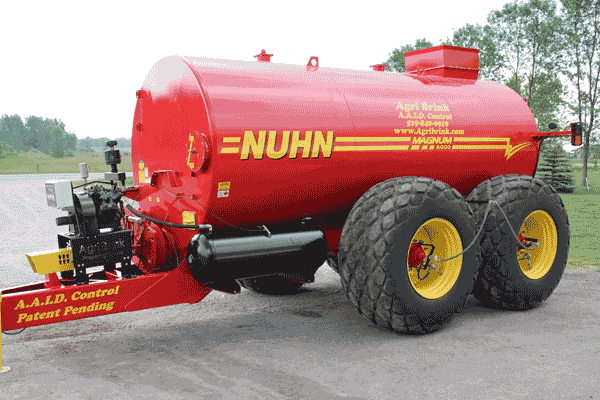Taking the pressure off
AN AUTOMATED SYSTEM THAT ADJUSTS TRACTOR TIRE PRESSURE PROTECTS THE SOIL AND THE BOTTOM LINE
growers are clocking more time on the road than ever, driving their equipment from farm to farm over large geographical areas. There is a need to make these trips as economical and efficient as possible — and a simple made-in-Ontario device is now available to do just that.
The key is quick and automatic tire pressure adjustment. AAID technology (Automatic Air Inflation Deflation) from Moorefield-based AgriBrink allows a farmer in the tractor cab to control tire inflation levels so that pressure is always optimized for the road and the field. “By reducing the tire pressure, a tire’s footprint widens and lengthens and this increases surface area and reduces soil compaction on your land,” says co-developer and AgriBrink president/owner Jake Kraayenbrink.
“You can program one tire pressure for roads, one for fields and one for corners in fields, but you can also change pressure on the go.” Tire pressure adjustment also decreases tire wear and reduces overall fuel consumption. Deflation occurs at a rapid 30 seconds from 40 psi to 14 psi on 30.5/32 tires.
It was also important to AAID’s designers that the unit have other user-friendly features. “In case any part of the control system fails, there’s a manual override,” says Kraayenbrink. “This prevents any farming downtime. We’ve also made it very easy to move the unit to other equipment such as a square baler, grain buggy or solid manure spreader. It sits on a quick-attach platform that has only four bolts.”
PHOTO 1: AGRIBRINK AAID SYSTEM ON A NUHN MANURE SPREADER

from idea to commercial sales
The idea for AAID came to Kraayenbrink several years ago. “We have a farrow-to-finish breeding stock hog farm with 300 acres and with sons getting into the family business, the downturn in the hog industry got us seriously thinking about additional forms of income,” he says. “Around that time, I heard of a presentation that described how changing a manure tanker’s tire pressure impacts the level of soil compaction, and then had a conversation with (fellow hog producers) Ed and his son Jamie about how in the trucking industry, they inflate and deflate tires to save on tire wear and reduce fuel consumption.” Kraayenbrink went to OMAFRA’s corn specialist Greg Stewart to talk about the idea and in 2009, Stewart found funding for a study of the technology. “I supplied a tanker and Greg Stewart and Sam Bradshaw did the research,” he says. “We contacted a company in the US that has a system for inflating and deflating the tires on army vehicles, but it was only for occasional use. In agriculture, it needs to be done three times an hour, so it wasn’t useful.”
In the study, they measured parameters like soil compaction and fuel consumption, inflating and deflating tires under lighter and heavier loads. Shortly after the study, they travelled to Europe, where tire pressure adjustment has been used by farmers for many years. The tour included Denmark, Holland, Germany, Belgium and France, with visits to two universities, six manufacturers and several farms. “We wanted to check out the systems and see if any of the manufacturers would supply us with a system for the research tank and have back-up support,” says Kraayenbrink. “Unfortunately, none were willing to do this, so a local manufacturer was sought.”
finding partners
Upon returning home, the team investigated a Canadian-made system for inflation and deflation of truck tires. “It works well for the needs of transport trucks on the road, but a system for agriculture needs to be quite different,” Kraayenbrink notes. “For one thing, it took too long — two minutes — and truck tires are high pressure, low volume. Tires on ag equipment are high volume, low pressure, so that has different requirements.” Things started to move forward when a call came in from tanker manufacturer Nuhn. “We’d gotten some media attention with the study and the trip and because of this, Nuhn had received a request for a tanker with an inflation-deflation system on it,” Kraayenbrink says. “Nuhn gave us the opportunity to develop a system for this order, and we took the challenge.” Kraayenbrink made a trip to see a neighbour, an engineer named Maurice Veldhuis, who came up with a design for the electronic control system. “We also went to Steve Bailey, a truck mechanic,” he says. “Steve had lots of ideas, and the thought of using a quick-release valve enabling quick changes in pressure.” The AAID system was born, with three components – an air supply (tanks and compressor), air delivery system (plumbing, stems, swivels) and air controls system.
The company officially started sales in April 2011. “We’ve been to lots of agricultural shows and events,” says Kraayenbrink. “We also received the Premier’s Award for Agri-Food Innovation Excellence this summer, which also provided some media attention.” The AAID has been added to the Environmental Farm Plan for energy efficiency and soil conservation. “You get 30 percent of the cost of the unit covered when installed on manure spreaders,” Kraayenbrink says. “There is a need for it, with equipment being heavier than ever, as a way to reduce soil compaction and tire wear and also conserve fuel.” •






















